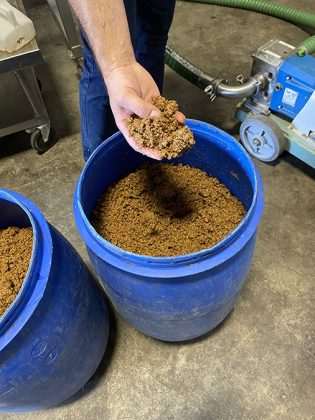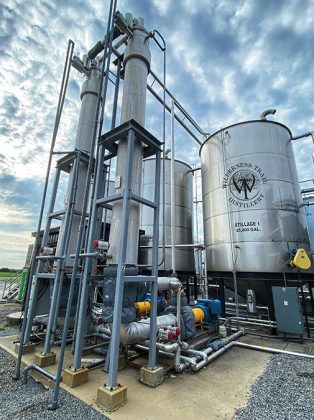Introduction
In March 2021, the University of Kentucky’s James B. Beam Institute for Kentucky Spirits worked in partnership with the Kentucky Cabinet for Energy and Environment, and the Distillers’ Grains Technology Council to study the current and emerging approaches for spent distillers’ grains dewatering at our region’s craft distilleries. A representative group of craft distillers from across the state helped frame the similarities and differences in their dewatering priorities. Dewatering technology providers discussed their technological solutions in this space. This article places these needs into context while highlighting the opportunities presented around dewatering distillery coproducts.
Spent grain coproducts and the case for dewatering
The craft segment of Kentucky’s distilled spirits industry continues to grow through continued investment. As new groups join this thriving community, there is an intentional emphasis on community relationships and environmental responsibility. The craft distillers pride themselves as strategic partners with their local community. Leveraging of their products and coproducts to support the local economy and food supply is a high priority. Grain coproducts offer significant opportunities for re-use in the community. It is critical that any system developed for a craft distiller supports the sustainability of the region. The most common current approach is direct feeding of whole stillage to local beef cattle, and the University of Kentucky Cooperative Extension Office supports education on responsible use of distillers’ grains as cattle feedstuffs. This strategy requires a strong commitment by both the distiller and farmer to keep both businesses viable. Open communication on production volumes and scheduling is essential. The large amount of water (>90% by mass) in whole stillage typically limits the hauling distance and feeding of whole stillage to farms within ~50 miles of the distillery. This local option emphasizes the importance of mutually beneficial partnerships which incentivize the responsible use of distillery coproducts.
As the production of Kentucky’s bourbon industry continues to grow, the ability to feed cattle in more remote regions is growing in importance. To improve the economics of remote livestock feeding, water must be removed to reduce transportation costs. Additionally, dewatered products command a significantly higher price on the livestock feed markets due to the higher feed value of the dewatered co-product. Here, we look beyond economic factors to other considerations for dewatering technology in a craft distillery setting.
Urban Distilleries have significant transportation and footprint considerations. Urban settings can be advantageous for driving brand awareness and foot traffic in a craft distillery but at a major disadvantage in proximity of farms for feeding stillage or byproducts. Additionally, the more robust water treatment facilities provide a costly option of disposal of grain coproducts through properly permitted sewer systems. Sewer disposal is mainly limited to major urban areas and misses a clear opportunity to supply the region with coproducts, but the livestock utilization of grains is complicated by transportation to remote farms. Transportation is more attractive with the increased nutrition per pound of dewatered coproducts from hauling less water and more valuable feed. Critically, exaggerated real estate prices in urban settings place a premium on distillery footprint. Any dewatering system intended for an urban craft distillery must provide a value that exceeds that of any additional footprint. Small compact systems are ideal in urban settings. The space limitations create a significant opportunity for mobile dewatering systems to handle batch-wise dewatering.
Site planning of dewatering systems must be carefully considered. A strategic layout is critical for the success of a dewatering system in all distilleries. These systems need to be accessible for transportation (typically by tanker truck) at all hours of operation due to the farming community’s working hours. The business of moving spent grain may not be ideal for a tourist experience, so site planning is essential. Thus, the reduction of trucking activity offered by dewatering will also likely provide an improved setting for tourism, road management and cost.
Site planning is also important for the operation of dewatering systems. Whole stillage emerges from most continuous stills as a well-mixed fluid at ~100˚C. Over time, the mixture cools and increases the viscosity of the whole stillage and solids separate from liquid making it more difficult to transfer the stillage to the farms. Additionally, any dewatering systems that leverage heat utilization will be challenged by remote locations at a facility. Finally, whole stillage is a suspension of grains, where any interruption of flow from unexpected shut downs may obstruct pipes, tanks, and hauling tankers. These obstructions are easier to handle thoroughly mixed and over short distances. In all, site planning is a major consideration to the adoption of any spent grain dewatering technology.
Implemented technologies for craft dewatering in Kentucky
While many technologies have been proposed for dewatering at the large and craft scale. The following technologies have been implemented at the craft distillery scale in Kentucky.
Centrifugation and sifting systems. The most common dewatering technologies at the craft scale are based on centrifugation, straining, sifting, and screw pressing. This technology leverages years of development for dewatering grains in brewing and distilled spirits at all production scales. The most common tradeoff in these technologies is the increase in power required for reduction in final water content of the grains. Simple vibratory separators require 1/3 to 2.5 HP to deliver a 60-70% water content in the solid coproduct. Higher power systems like centrifugal sifters lower the water content to 40-50% with 1-7.5 HP. Full decanting centrifuges can require up to 100 HP to get water content below 40%. These types of systems can be optimized for a small footprint, and they function effectively with hot liquid streams or at room temperature. These systems are great for removing liquid from the whole stillage, but they must be paired with a separate solution for treating or reclaiming the liquid portion of the stillage.
Ultrafiltration with two stage reverse osmosis. The development of robust stainless steel ultrafiltration membranes offers new opportunities in stillage dewatering. Most importantly, these systems can be paired with other membrane systems to offer a powerful advantage of on-site water reclamation. In the system currently in place at Wilderness Trail Distillery, the ultrafiltration system sends a liquid stream of ~2% solids to a sequential forward osmosis and reverse osmosis unit to produce potable water. The solids are in a stream of 85% water, and this mixture has reduced settling of the suspended solids during transportation that allows for extended hauls and ease of evacuation of the tanker’s contents. The footprint of this system is more modular and less extensive than common alternatives for full processing with no discharge, but equipment vendors are rapidly developing alternative form factors with improved space utilization. While successfully piloted, the full potential of this technology may not be fully realized in this first implementation.
Anaerobic digestion. Anaerobic digestion systems are operational in Kentucky and utilize feedstocks from a variety of mash bills without issue. While not strictly dewatering, digestion is an effective approach to handling thin stillage that is produced from other dewatering technologies. In general, a digester can process twice the volume of thin stillage as whole stillage. A typical system will take 15-20 days to process a single batch of whole stillage, and turnover time varies seasonally. These systems require a significant footprint and biological operating expertise. Distillers typically leverage an external partner with a dedicated digestion facility.
Conclusions and future needs
Ultimately, dewatering offers a strategic path to improve transportation economics and increase the value of spent grains coproducts. There is still a significant need for innovation in this space especially as dewatering typically does not remove dissolved solids, and thus wastewater streams still need remediation. Increased education of distillers, farmers, and others on the proper optimal use of spent grains is imperative to moving this initiative forward. There are many opportunities to understand research how to best formulate Kentucky’s unique spent grains to improve cattle digestion and yields. Additionally, we will continue to seek out new dewatering technologies to address the needs of Kentucky’s craft distillery community. Finally, there was significant conversation concerning local craft distiller cooperation to reach grain coproduct volumes that would enable dryhouse-scale technologies. We hope this preliminary conversation will accelerate new technology towards solutions that best satisfy the complex needs in this landscape.
Definitions
Whole stillage — Mixture of ~90% water and ~10% spent grains emerging from a distillery at ~100C.
Thin stillage — Mixture of 95% water and 5% spent grains that comes from centrifuging or straining the whole stillage.
Wet cake — Mixture of 60-70% solids and 30-40% spent grains.
Co-Authors
James B. Beam Institute for Kentucky Spirits, University of Kentucky, Lexington, KY 40506. Att: Brad Berron, Jarrad Gollihue.
Department of Chemical and Materials Engineering, University of Kentucky, Lexington, KY 40506. Att: Brad Berron.
Department of Biosystems and Agricultural Engineering, University of Kentucky, Lexington, KY 40506. Att: Donald Colliver.
Department for Environmental Protection, Kentucky Energy and Environment Cabinet, Frankfort, KY 40601. Att: Kari Johnson, Amanda LeFevre.
Distillers Grains Technology Council, Ames, IA 50011. Att: Kurt Rosentrater.
Department of Agricultural and Biosystems Engineering, Iowa State University, Ames, IA 50011. Att: Kurt Rosentrater.
Kentucky Distillers Association, Frankfort, KY 40601. Att: Sara Barnes.
Log Still Distillery, Gethsemane, KY 40051. Att: Lynne Dant.
Castle & Key Distillery, Frankfort, KY40601. Att: Jason Gambrell.
Kentucky Peerless Distilling Company, Louisville, KY 40202. Att: Caleb Kilburn.
Kason Corporation, Millburn, NJ 07041. Att: Jim Ling.
Mac Farms, Inc., Campbellsville, KY 42718. Att: John McLean.
Kentucky Artisan Distillery, Crestwood, KY 40014. Att: Jade Peterson.
National Corn to Ethanol Research Center, Southern Illinois University-Edwardsville, Edwardsville, IL 62025. Att: Yan Zhang.










